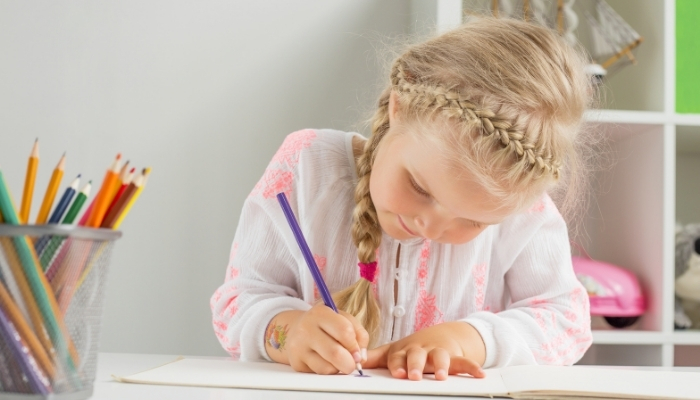Helping your child stay interested in reading can be tricky. Research shows that only 32.7% of children aged 8–18 enjoy reading in their free time, which makes keeping them engaged even more challenging.
That is why motivating your child to keep a kids' reading journal gives them a simple, fun way to reflect on stories, track their progress, and feel proud of their reading achievements.
In this blog, you’ll find practical tips for keeping a reading journal, creative prompts to spark ideas, and a breakdown of common challenges children face with reading journals, along with simple ways to overcome them.
Key Takeaways
-
Reading journals turns reading into an interactive, reflective, and enjoyable experience for children.
-
Journals strengthen comprehension, writing skills, vocabulary, and personal connections to stories.
-
Simple strategies like daily logs, creative prompts, and personalization keep journaling engaging and build confidence.
-
Recognizing and addressing common challenges ensures journaling remains enjoyable, empowering children to write, draw, and express themselves freely.
What Is a Reading Journal?
A reading journal is a place where readers record their thoughts, feelings, and reactions about the books they read. It helps organize ideas, track progress, and reflect on stories in a personal way.
It can be as simple as a notebook where notes, summaries, questions, or sketches are written after reading. The goal is to create a space for engaging with books and exploring a deeper understanding.
Each journal can be different depending on how someone chooses to use it. Some include detailed observations about characters and plot, while others focus on favorite scenes or questions that arise while reading.
What are the Benefits of Keeping a Reading Journal for Kids?

Reading journals bridges the gap between reading and understanding. They slow down the process just enough for real learning to happen.
When children write about books, their brains work harder to process information. They start asking "why" instead of just "what happened next."
-
Better Story Understanding Writing encourages children to consider plot connections. They notice character growth they might have missed. Stories become puzzles to solve rather than just entertainment.
-
Stronger Writing Skills: Regular practice builds fluency naturally. Children find their voice through consistent writing. They learn to express complex thoughts in simple words.
-
Deeper Thinking Habits Journals push children beyond surface reactions. They learn to support opinions with story evidence. These analytical skills transfer to all subjects.
-
Personal Story Connections: Children relate book themes to their own experiences. Stories become mirrors reflecting their lives. This connection makes reading personally meaningful.
-
Growing Vocabulary: New words get explored and remembered through writing. Context becomes clearer when children explain the meanings themselves. Vocabulary grows organically rather than through forced memorization.
-
Reading Excitement: Anticipating journal writing adds purpose to reading. Children read more carefully when they know they'll reflect on what they have read later. The practice builds genuine enthusiasm for books.
-
Improved Memory: Writing about books creates stronger memory pathways. Children remember plots and characters longer. Their journal becomes a personal library of reading experiences.
These benefits compound over time. Your child develops into a thoughtful reader who engages deeply with every story.
Also Read: 130 Kindergarten Writing Journal Prompts and Ideas
How to Start a Kids' Reading Journal?
Starting feels overwhelming when you overthink it. Keep things simple and let the habit build naturally.
Visit a store together and let your child pick their notebook. Ownership matters more than you might think. When they choose it, they're more likely to use it.
-
Pick the Right Journal Together: Let them choose based on what appeals to them. A composition book can work just as well as an expensive journal. Their connection to it matters most.
-
Start Small and Simple: Begin with one sentence after reading. "I liked when..." or "The best part was..." gives them a starting point. Build complexity gradually as comfort grows.
-
Find a Quiet Writing Spot: Good lighting and comfortable seating indicate that this activity is valued. A consistent location helps establish the routine. Make it feel special, not like punishment.
-
Set a Regular Time: Reading immediately after work is well-suited for most children. The story stays fresh in their minds. Consistency builds habits faster than sporadic efforts.
-
Show Genuine Interest: Ask about their entries without being intrusive. "What did you write about today?" shows you care. Your attention motivates continued participation.
-
Offer Starting Ideas: When they feel stuck, suggest simple prompts to help them get started. "Tell me about your favorite character" gets thinking started. Don't overwhelm with too many choices.
-
Skip the Red Pen: Focus on ideas, not spelling or grammar. Journals are thinking spaces, not writing tests. Criticism kills the joy in this process.
Some children embrace journaling immediately. Others need weeks to see its value. Your patience and genuine interest make the difference.
Also Read: Kindergarten Reading Level Guide and Tips
Next, let’s explore some journal ideas to help you start this practice with your child effortlessly.
Ideas and Tips for Keeping a Reading Journal for Kids

Variety keeps journals interesting. When children have options, they tend to stay engaged for longer periods. Different approaches work for other books and moods.
The goal is to make reflection feel natural, not forced. Your child should look forward to journal time, not dread it. Mix and match these ideas based on what works.
Daily Reading Log
A daily reading log in a journal helps children see how much they’ve grown as readers. Writing their own entries builds awareness of reading habits, pace, and preferences, boosting confidence and encouraging reflection.
-
Encourage your child to write the book title, author, start date, and end date for each reading session.
-
Have them record total pages read or minutes spent reading to notice progress over time.
-
Ask them to write a simple rating or comment about the book using stars, colors, or a few sentences.
-
Support them in tracking milestones in writing, such as completing a set number of books or pages, using charts or stickers in the journal.
-
Let your child set personal goals in writing, such as reading a certain number of books or a specific number of minutes daily.
Reflections and Reactions
When kids connect with stories on a deeper level, reading becomes more meaningful. These reflections help them build empathy and self-awareness.
-
Ask feeling-based questions such as “How did that scene make you feel?” or “What would you do differently?”
-
Encourage comparisons like “This character reminds me of…” to connect fiction with real life.
-
Explore themes from the book by examining how they relate to experiences such as friendship or bullying.
-
Welcome honest reactions, even if they are negative. If they dislike a book, ask why. Learning to explain opinions builds critical thinking.
-
For example, after reading Where the Red Fern Grows, ask your child to write three sentences about Billy’s determination or list questions about why the story made them emotional.
Vocabulary Builder
Journaling new words, their meanings, and example sentences turns vocabulary into a hands-on learning experience. Kids remember words better when they write them down.
-
Create a section for unfamiliar words and include the sentence where the word was found. Seeing how it is used helps with understanding.
-
Let your child guess the meaning before looking it up. Context clues and prior knowledge build confidence and encourage independence.
-
Turn vocabulary into fun games. Can they create a new sentence with the word or invent a silly story using multiple new words?
-
Review new words regularly. Self-testing helps move them into long-term memory.
Also Read: Understanding Text and Reading Strategies
Gratitude and Positive Notes
When children jot down what they liked or learned from a story, it highlights positive moments and lessons. Writing about these makes the reading experience more memorable.
-
After finishing a book, ask what they appreciated about the story. Maybe it was a character’s kindness or a vivid description.
-
Help them connect story lessons to real-life experiences. If a character shows courage, they can write about someone they know who is brave.
-
Include space for self-encouragement, such as “I read my first chapter book!” or “I learned ten new words this week!” These notes build self-confidence.
-
Track their growth over time by comparing their current reading skills with those from earlier periods.
Creative Components: Drawing, Coloring, and Storytelling

Adding drawings, story maps, or comic strips alongside writing helps kids express ideas visually and in words. Journals become a space for imagination and understanding.
-
Motivate your child to draw favorite scenes or characters. Artistic skill is not essential; the act of drawing helps with memory and understanding.
-
Try story maps or character webs to connect events and relationships. Visual organizers support comprehension by making abstract ideas easier to grasp.
-
Comic strips are a fun way to summarize books. Let your child draw key scenes with speech bubbles to bring stories to life.
-
Add coloring pages that relate to book themes.
Reading Challenges and Milestones
Challenges and milestones give kids something to aim for. Achievements, whether big or small, build perseverance and excitement for reading.
-
Create age-appropriate challenges, such as “Read a book where an animal is the main character” or “Try a new genre.”
-
Make progress visible. A rocket with sections to color in as they read or a tree with leaves representing books finished can help motivate them.
-
Celebrate milestones in meaningful ways. Completing their first chapter book can be recognized with a photo, a congratulatory note, or a small celebration.
-
Balance short-term weekly goals with longer-term monthly ones to maintain momentum and excitement.
Book Reviews and Wish Lists
Writing book reviews teaches kids how to form opinions and support them with examples. Keeping a wish list builds planning skills and curiosity.
-
Start with simple ratings like stars or thumbs up and ask your child to explain why they chose that rating.
-
Add more detailed reviews as they become comfortable, including thoughts on plot, characters, and what they liked or didn’t like.
-
Keep a wish list of books they want to read next. It can include recommendations from friends or ideas they find while browsing.
-
Compare books by the same author or in the same series to spot patterns in writing style or themes.
Parent and Teacher Notes
Support from adults helps children feel valued and encourages them to continue reading. Journals can be a space where this connection is strengthened.
-
Leave encouraging notes, commenting on insights or improvements you notice.
-
Share observations about their reading growth, such as improvements in fluency or vocabulary.
-
Suggest books or activities that match their interests. If they enjoy mysteries, recommend new titles. If they struggle with comprehension, offer helpful tips.
-
Use the journal as a bridge between home and school.
Personalization and Keepsakes
When kids feel a journal is truly theirs, they are more invested in using it. Personal touches make journaling an experience they cherish.
-
Let them decorate the cover with stickers, drawings, or photos. Creative touches build ownership and pride.
-
Include photos from reading outings or quiet reading spots to create memories.
-
Add sections for special interests, such as poems or facts about animals from books they love.
-
Allow them to express themselves in their own style. Lists, sketches, or notes are all valid forms of response.
Privacy and Support
Balancing privacy and encouragement helps kids feel safe and motivated to share their thoughts.
-
Set clear boundaries about when you’ll read entries and what will stay private.
-
Read their entries when invited and ask thoughtful questions that encourage deeper thinking.
-
Focus on ideas rather than grammar or spelling. Journals are a space for exploration, not perfection.
-
Offer steady encouragement through praise and attention. Show them that their insights and efforts matter.
These varied approaches keep journals fresh and engaging. Your child develops strong literacy skills while exploring creativity and engaging in personal reflection. With these principles in mind, let’s look at some journal ideas to make reflection fun, engaging, and effortless for your child.
Fun Prompts to Kickstart Kids' Reading Journal Entries

Good prompts spark thinking when children feel stuck. They connect books to personal experiences and deeper reflection. The right question can unlock insights children didn't know they had.
Character Connections Prompts
-
Which character would you want to be friends with? Why?
-
What advice would you give the main character if you could?
-
Does any character remind you of someone you know? Who and why?
-
How would you handle the main character’s biggest problem?
-
If you could invite one character to dinner, who would it be and what would you talk about?
-
What do you and your favorite character have in common?
-
If you met this character, what questions would you ask them?
Story Reactions Prompts
-
What surprised you the most in this story?
-
If you could change one part, which would it be and why?
-
What do you think happens after the story ends?
-
How would the story be different if it happened in today’s world?
-
Which scene would you definitely want in a movie version?
-
What part made you feel really excited, sad, or scared?
Personal Connections Prompts
-
Does this story remind you of something that happened to you? How?
-
What did you learn about friendship from this book?
-
Was there a part that made you laugh or smile? Which one?
-
How did your feelings change while reading the story?
-
What worried you about the characters or their choices?
-
Which scene made you laugh out loud?
Creative Thinking Prompts
-
Could you draw your favorite scene and explain why you chose it?
-
If you lived in this story, what would you do differently?
-
Write a letter to your favorite character.
-
Design a new cover for the book. What would it look like?
-
Imagine a sequel to this story. What happens next?
-
Create a different ending that you think would be even better.
Learning and Discovery Prompts
-
What new things did you learn from this book?
-
Were there any words you didn’t know before? What do they mean now?
-
Do you still have any questions about the story?
-
Did this book change how you think about something? How?
-
What would you tell your friends about this book?
-
What do you want to learn more about after reading it?
Select prompts that align with your child's interests and the specific book they're reading. Some children love character analysis, while others prefer creative responses.
Also Read: How to Help Your Child Struggling with Writing Skills
What Challenges Do Kids Face When Journaling and How Can You Help?

Every child faces obstacles with journal writing. Recognizing these challenges early helps you provide the proper support. Most problems have simple solutions once you understand the root cause.
"I Don't Know What to Write"
This happens when children feel overwhelmed by blank pages. They want to say something meaningful but can't find the right words.
Try This:
-
Advise them to try sentence starters like "My favorite part was..." or "This character made me think about..." Give them specific questions rather than open-ended prompts.
-
Let them draw first, then write about their pictures.
-
Sometimes talking helps more than writing. Let them tell you about the book first, then write down what they said.
"Writing Takes Forever"
Some children have great ideas but struggle with the physical writing process. Slow handwriting frustrates them and creates negative associations.
Try This:
-
Accept shorter entries. One good sentence beats nothing at all.
-
Consider digital options, such as tablets or computers, if handwriting struggles persist. Voice recording apps can capture thoughts that writing later struggles to express.
-
Break writing into smaller pieces. Multiple short sessions often work better than a single, long, and frustrating one.
"I Can't Remember the Book"
Waiting too long between reading and writing causes this problem. Story details fade quickly from memory, making reflection a challenging task.
Try This:
-
Write immediately after reading when possible.
-
Use sticky notes to mark interesting parts while reading. Let them flip through the book while writing to refresh their memory.
-
Start with simple plot summaries before attempting deeper analysis. Short books work better initially than long chapter books for building this habit.
"I Hate This Book"
When children dislike their reading material, journal resistance follows. They feel they have nothing positive to contribute.
Try This:
-
Validate that not every book appeals to every reader.
-
Help them identify specific elements they disliked and why. This critical thinking also has value.
-
Use dislikes as learning opportunities about personal preferences. Let them choose different books that better match their interests.
"This Feels Like Homework"
Over-structuring journals makes them feel like school assignments. Children lose the personal connection that makes journaling powerful.
Try This:
-
Give them control over timing and topics. Let them choose their own prompts when possible. Keep your involvement supportive rather than evaluative.
-
Make the journal truly theirs by personalizing it. Celebrate their unique perspectives.
"I'm Not Good at Writing"
Some children find writing challenging and may feel unsure about recording their ideas. They assume their ideas aren't worth recording.
Try This:
-
Accept drawings, lists, and other formats beyond paragraphs. Start with verbal discussions before any writing. Focus entirely on their ideas rather than writing mechanics.
-
Show genuine interest in their thoughts and observations. Remind them that all writers started as beginners.
Keeping these challenges in mind will help you guide your child toward confident, consistent journaling, making reading more engaging and meaningful.
Conclusion
Keeping a kid's reading journal can turn their reading sessions from a simple task into a fun, personal adventure. Writing, drawing, and reflecting help children explore ideas, connect with stories, and build confidence while sharpening their thinking skills.
The great thing about a reading journal is that it’s completely flexible. Every child can make it their own, finding the style and approach that makes reading enjoyable for them.
At FunFox, we see this transformation in action every day. Our programs make reading and writing fun while strengthening essential literacy skills:
-
Readers Club: Interactive sessions that build reading skills and a love for books.
-
Writers Club: Creative activities to grow expression, storytelling, and communication.
-
Small group classes: Personalized attention to match each child’s learning style.
-
Experienced teachers: Skilled professionals who make reading and writing engaging.
Make reading joyful for your child again. Book a trial class with FunFox today and help your child start their own reading journal journey while building strong reading and writing skills.
FAQ’s
1. What to write in your child's reading journal?
Write thoughts, feelings, and reactions about books. Include summaries, favorite scenes, new vocabulary, character reflections, personal connections, questions, and creative drawings to capture understanding and encourage deeper engagement with the story.
2. What is a reading journal example?
A reading journal example can include a daily log with book title, author, reading duration, key events, favorite quotes, vocabulary notes, personal reflections, and simple ratings or drawings to track progress and ideas.
3. How to start a journal example?
Begin with one sentence after reading, such as “My favorite part was…” or “I learned…” Add simple prompts, a summary, or a quick drawing to make journaling manageable and engaging.
4. What happens in the brain when journaling?
Journaling activates memory and comprehension pathways, improves analytical thinking, strengthens writing skills, and reinforces vocabulary. Writing reflections encourages more profound understanding and helps children connect personally with the story.















